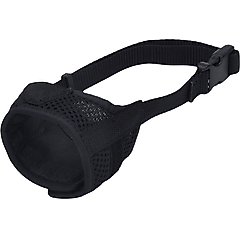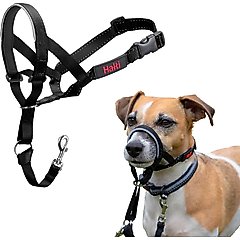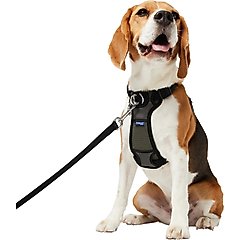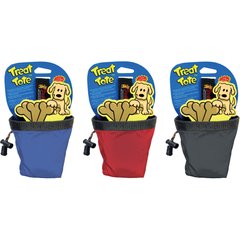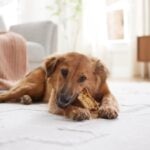What Is Dog Aggression? What Are the Signs?
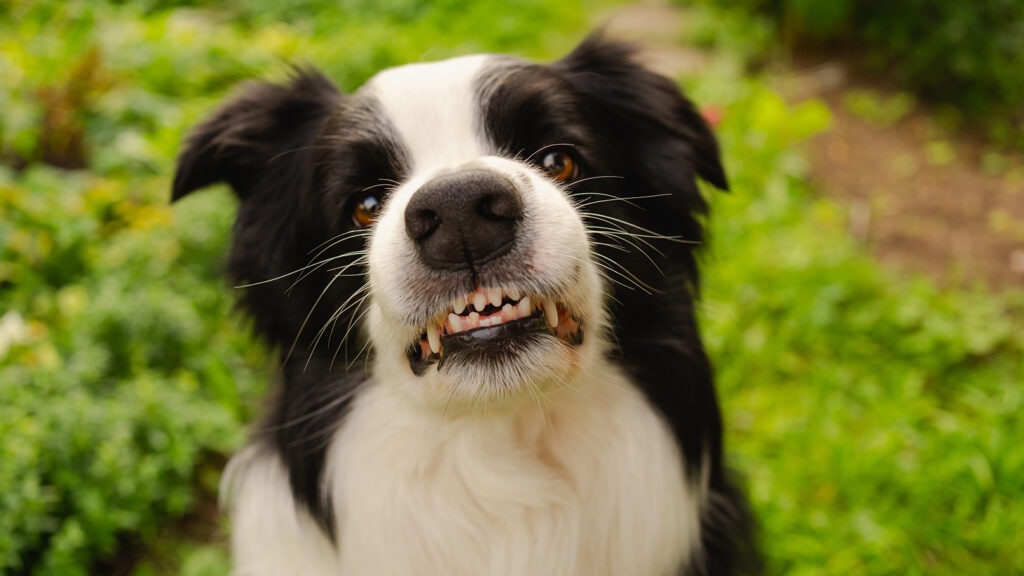
Photo by Iuliia Zavalishina/iStock/Getty Images Plus
Dog aggression can be alarming, whether it’s nipping a stranger or lunging at another dog during a walk. While it’s easy to assume aggression means a dog is “bad” or dangerous, the truth is more nuanced.
Aggression is a form of communication, often signaling that a dog is uncomfortable, afraid, or trying to protect something they value.
We spoke to two dog behavior experts to understand the types, causes, and signs of dog aggression and how to build better behavior through positive reinforcement and professional support.
What Is Dog Aggression?
Dog aggression is a behavior dogs use to communicate discomfort, fear, or a need to protect something, whether it’s their food, toys, territory, or even their favorite person. It can show up in many ways, including growling, snapping, barking, lunging, or biting.
At its core, aggression is a natural reaction to something a dog sees as a threat. It might seem sudden, but most dogs give warning signs before things escalate. Learning to spot and understand these signals is crucial for addressing the behavior and keeping everyone safe.
13 Types of Dog Aggression
Dog aggression isn’t one-size-fits-all. There are many different types, each with its own causes and triggers. These include:
- Leash aggression: Reactivity on leash due to frustration, fear, or feeling restrained; may include barking, growling, or lunging during leashed walks.
- Barrier aggression: Aggression when blocked by fences, crates, or windows; behavior may change (for better or worse) when the barrier is removed.
- Fear-based aggression: Defensive behavior triggered by fear or feeling threatened; often paired with body language, such as crouching or avoiding eye contact.
- Pain-based aggression: Sudden snapping or biting when touched, especially near an injury or sore area; often linked to an underlying health issue.
- Redirected aggression: Occurs when a dog can’t reach a target and redirects frustration onto a nearby person or pet.
- Possessive aggression (resource guarding): Growling or snapping to protect food, toys, beds, or people.
- Territorial aggression: Aggression triggered by perceived threats to a dog’s home or space, especially when strangers enter the yard or house.
- Social aggression: Aggression during interactions with other dogs or humans, often due to confusion about social hierarchies or poor socialization.
- Defensive aggression: A last-resort “fight” response when a dog feels cornered and can’t escape.
- Maternal aggression: Protective behavior from a mother dog when she feels her puppies are at risk.
- Predatory aggression: Instinct-driven behavior, such as chasing or stalking smaller animals.
- Sex-related aggression: Aggression aggravated by hormonal changes or reproductive cycles, particularly between intact dogs of the same sex.
- Idiopathic aggression: Aggressive behavior with no definable pattern or triggers; typically considered neurological in origin.
What Are the Warning Signs of Aggression in Dogs?
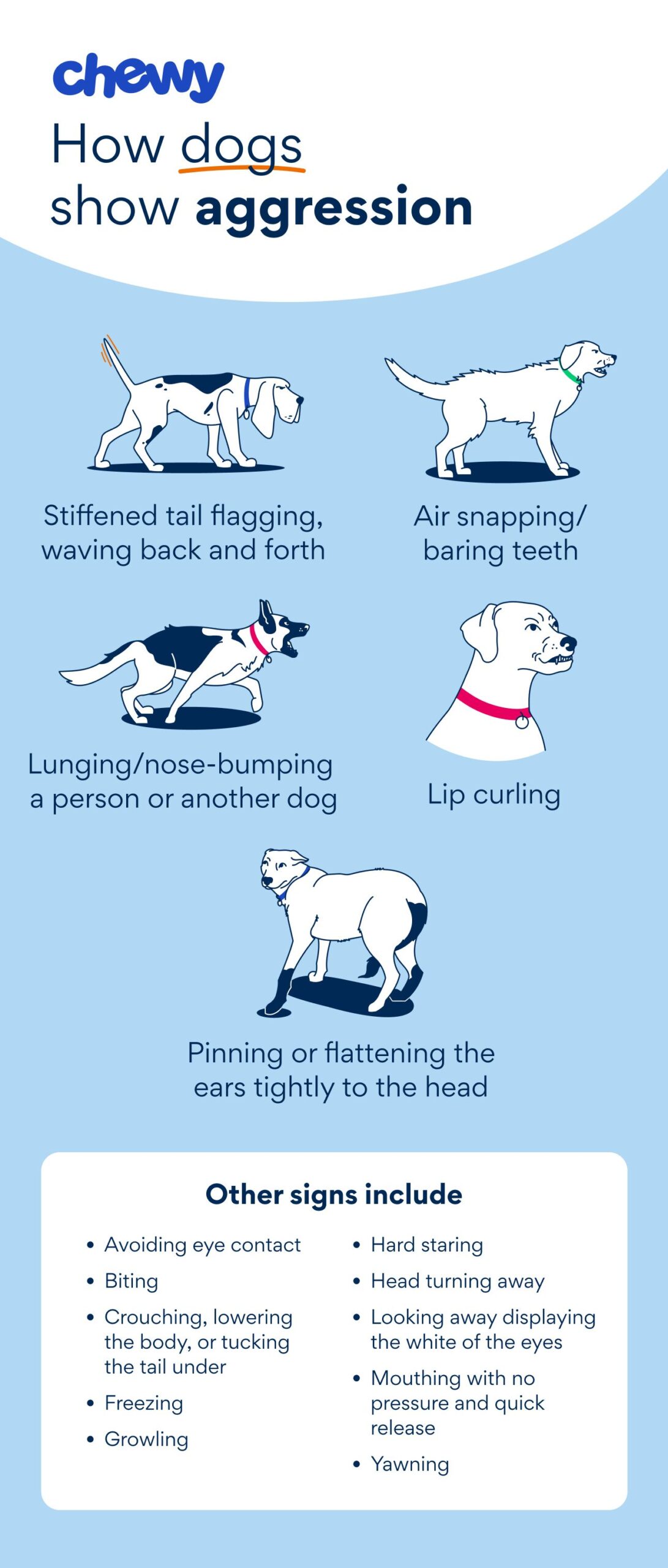
Photo by Chewy
Many dogs express their discomfort through subtle body language before things escalate. Being able to spot these warning signs of aggression can help you step in before a situation gets out of hand.
Here are some common signs to look for:
- Air snapping
- Avoiding eye contact
- Baring teeth
- Biting
- Crouching, lowering the body, or tucking the tail
- Freezing
- Growling
- Hard staring
- Lip curling
- Lip licking
- Looking away, displaying the whites of the eyes
- Lunging
- Mouthing with no pressure and quick release
- Nose-bumping a person or another dog
- Pinning or flattening the ears tightly to the head
- Tail flagging with stiff waving back and forth
- Turning the head away
- Yawning
Why Is My Dog Getting Aggressive? 9 Possible Causes
“Many factors can contribute to why a dog might behave aggressively, and multiple factors can affect how it ultimately plays out,” says Collin Roche, CPDT-KA, a certified professional dog trainer and owner of Courageous Canines in Trenton, New Jersey.
According to Roche, these are the most significant causes:
Lack of Socialization
Roche says this is typically the most significant factor. Dogs who haven’t been properly exposed to other dogs, people, or different settings during their critical development period might not know how to interact calmly or appropriately.
Past Trauma or Negative Experiences
Any experience a dog perceives as traumatic can lead to a negative association, causing similar situations in the future to trigger overarousal or aggression, Roche explains.
Stress and Overarousal
“Any dog who is pushed beyond their ability to handle stress exceeds what we call their ‘stress threshold,’” Roche says. “At that point, the conscious brain essentially shuts down and the survival brain takes over, leaving dogs with four main options: fight, flight, freeze, and fidget.”
Frustration
Certain types of aggression, such as leash and barrier aggression, often stem from frustration caused by being physically restrained, preventing the dog from engaging in natural behaviors, Roche explains.
Genetics and Parental Temperament
According to Roche, a dog’s breed and original working purpose can influence their behavior. For example, breeds developed for herding, guarding, or hunting might be more likely to exhibit guarding or protective behaviors, which can escalate to aggression when triggered.
However, he notes that a puppy’s temperament is even more strongly influenced by their parents, with those born to fearful or reactive dogs more likely to develop similar traits.
Competition
“Multiple dogs in a home typically consider each other to be competitors for access to resources, which can be as simple as things like food bowls, bones, and toys—or more complicated, like preferred resting places or access to a person’s attention, affection, and play,” Roche says.
“This is especially prone to happening over access to limited resources in a limited environment.”
Medical Issues
Illnesses, injuries, or undiagnosed conditions like arthritis or dental disease can make dogs irritable or defensive, especially when touched.
Lack of Stimulation
A bored, underexercised dog can become frustrated, and that frustration might come out as aggression.
Old Age
Aging dogs can become more irritable, which could lead to aggression.
Even if your dog has been friendly their whole life, age-related issues such as pain, balance problems, hearing or vision loss, and early dementia can contribute to increased sensitivity and aggression.
How Do I Correct Aggressive Dog Behavior?
Correcting aggressive behavior in dogs isn’t about punishment—it’s about understanding the root cause and using positive, consistent dog aggression training strategies to shift their response. Here are key steps you can take.
Rule Out Medical Issues
Before addressing behavior, schedule a vet visit to make sure your dog isn’t in pain or suffering from a health issue that’s contributing to their aggression.
Seek Professional Help
“Pet parents need to seek professional help ASAP, as soon as their dog exhibits aggressive behavior,” says Wailani Sung, MS, PhD, DVM, DACVB, FFCP, a board-certified veterinary behaviorist and owner of Bay Area Vet Behavior in the San Francisco Bay Area.
It’s important to work with a trainer who uses positive reinforcement techniques.
In more serious cases, a consultation with an animal behaviorist or a board-certified veterinary behaviorist might be necessary, she adds. Use the IAABC Behavior Consultant Directory or the CCPDT Trainer Directory to find a professional near you.
Implement Training on Your Own
With the guidance of a trainer, implement positive reinforcement, desensitization, and counter-conditioning in your daily routine.
These techniques teach your dog to stay calm and form positive associations with things that once triggered aggression.
Manage—Don’t Force—Social Situations
If your dog is aggressive toward people or other pets, don’t push interactions. Use behavior management tools, such as muzzles, leashes, no-pull headcollars, no-pull harnesses, or visual barriers to keep everyone safe while you work on behavior change.
Recommended Products
Be Patient and Consistent
Behavioral change doesn’t happen overnight. Stay consistent with your training plan, keep reinforcing calm behavior, and celebrate small wins. Every dog progresses at their own pace.
How Do I Prevent Aggression in My Dog?
Preventing aggression starts long before your dog ever shows signs of it. With the right training, environment, and habits, you can help your dog feel secure, confident, and well-adjusted.
Here are key steps to help prevent aggressive behavior before it starts.
Start Socialization Early
“The best thing a pet parent can do when they get a puppy is to take [the pup] to puppy socialization classes and do additional socialization on their own,” Dr. Sung says.
She explains that puppies who receive plenty of early socialization often grow into well-adjusted, resilient adult dogs who are less likely to develop behavioral issues.
Roche agrees, adding that the primary window for a dog’s social development is the first four months of puppyhood. If possible, socialization should include positive classic conditioning exercises and thorough desensitization to affection, interaction, restraint, eye contact, and examination with people of many ages and backgrounds.
Use Positive Reinforcement From the Start
Train your dog using rewards, such as treats, praise, or play. This helps build trust and encourages your dog to repeat good behaviors. Avoid punishment, which can lead to more fear and reactivity.
High-value training treats, such as Vital Essentials Beef Liver Freeze-Dried Raw Treats or Zuke’s Mini Naturals Peanut Butter & Oats Treats, and a treat tote, like the Chuckit! Treat Tote, are perfect for rewarding good behavior on the go.
Recommended Products
Set Clear Boundaries and Routines
Dogs thrive on structure. Consistent daily routines, such as regular mealtimes, potty breaks, exercise, and training, help reduce anxiety and create a sense of security.
Clear boundaries, such as not allowing jumping on guests or keeping off certain furniture, also help your dog understand what’s expected of them.
Provide Plenty of Mental and Physical Exercise
Bored, under-stimulated dogs are more likely to act out. Daily walks, interactive toys, puzzle feeders, and games like fetch keep your dog’s body and brain busy.
A few popular dog toys and puzzles to keep your pup busy include the Brightkins Brain Teaser Treat Puzzle, the Frisco Trash Can & Raccoons Hide & Seek Puzzle Squeaky Toy, and the Starmark Treat Dispensing Chew Ball.
Recommended Products
Watch for Early Warning Signs
Body language such as growling, freezing, pinned ears, or lip curling is often an early sign a dog is uncomfortable.
Don’t ignore these cues. Intervene early and calmly remove your dog from the situation if needed.
Work With a Professional Early On
When you first get your dog, bringing in a certified dog trainer or behaviorist can help set good habits from the start.
Early guidance ensures you’re reinforcing the right behaviors and helps prevent issues such as fear or aggression from developing down the road.
FAQs About Dog Aggression
Q: Are certain dog breeds considered more aggressive than others?
A: Some breeds might have natural tendencies to protect and guard that can increase the chances of aggressive behavior. However, any dog, regardless of breed, can become aggressive under the right circumstances, Dr. Sung says.
A dog’s upbringing, training, environment, and individual temperament all play a larger role than breed alone, she adds.
Q: Why is my dog being aggressive all of a sudden?
A: Sudden aggression could be a sign of pain, illness, or stress. It might also stem from fear, a recent environmental change, or a past trauma being triggered.
A veterinary checkup is a good first step to rule out any medical causes.
Q: What is the most common form of aggression in dogs?
A: According to Roche, most cases he sees involve dogs showing aggression toward other dogs or animals. This can be due to fear, lack of socialization, or territorial instincts, especially when dogs feel their space or resources are being threatened.
Q: Can dogs be aggressive toward their parents?
A: Yes, dogs can show aggression toward their pet parents, especially if they feel threatened, are guarding resources, or are in pain.
Q: Can aggression in dogs be “cured”?
A: According to Dr. Sung, there is no 100% cure for aggression, but many cases can be improved and successfully managed through consistent training, behavior modification, and professional guidance, though the outcome largely depends on the root cause.
